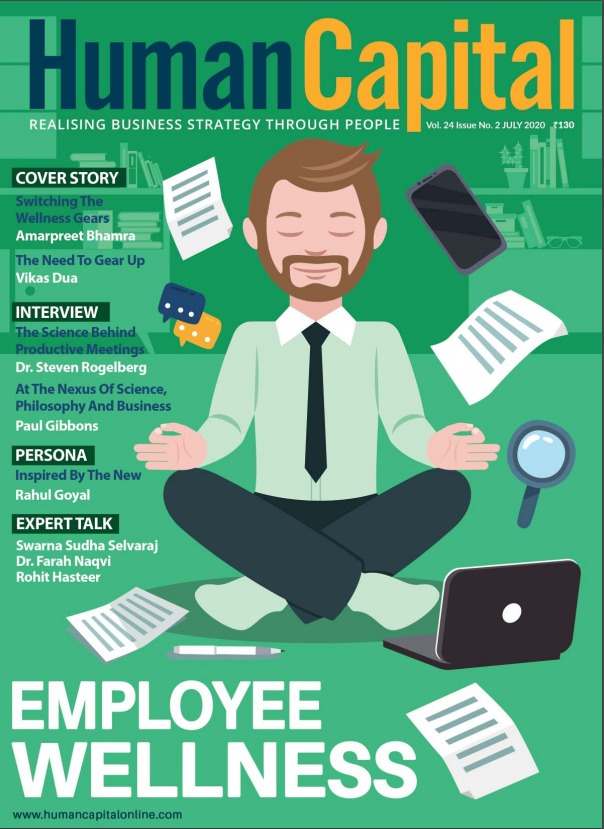
HR Is Uniquely Positioned and Skilled to Solve the Meetings Problem: Steven Rogelberg
- By ANKITA SHARMA |
- Aug 01 2020
Human Capital interacted with Dr. Steven Rogelberg, Chancellor's Professor at the University of North Carolina Charlotte, bestselling author and the world's leading expert on meeting science, to understand how science can help fix bad meetings.
He gives evidence-based tips on running effective and inclusive meetings and also offers practical advice on how leaders and HR professionals are uniquely positioned to ensure meeting success within their organisations.
Interestingly, one of the many hats you wear is that of a meeting scientist. Your recent highly acclaimed book, The Surprising Science of Meetings, comes out of the vast amount of research you have conducted over the past two decades. What does science reveal about meetings that might surprise us?
What surprises people the most is that there is a robust science, which demonstrates that while bad meetings take a toll on people and teams, meetings done well promotes employee engagement, inclusion, innovation, and team success.
Science helps identify an evidence-based path forward, around the key drivers of meeting success. At the same time, it also helps us understand which practices don’t have the value that conventional wisdom seems to suggest.
For example, the research on having a meeting agenda in and of itself shows a little actual direct benefit on meeting performance. But, if we stop and reflect, this should not surprise us. What matters most is what is on the agenda, its relevance to attendees, and how the meeting is facilitated.
Here is something to consider with agendas. As opposed to a set of topics to be discussed, try organising the agenda as a set of questions that need answers. This creates focus and clarity for the purpose of the meeting. Invite only those relevant to the questions at hand. By framing agenda items as questions, you know when to end the meeting. The meeting has been successful when or if the questions have been answered.
Running inclusive meetings is difficult. It can be even more challenging to run remote meetings that engage all team members in brainstorming and give them a sense of belonging. How can leaders make meetings more inclusive for all participants?
One should always strive to be an active meeting facilitator, regardless of who the attendees are. Draw people in (e.g., ‘Sandy, please share your thoughts’) to keep attendees engaged. Consider maintaining a tally to be sure that all voices are heard. Instead of saying ‘any questions or comments’, call on people by name to share their thoughts.
Also, don’t let people go off track; interrupt and redirect them if necessary. After all, that is your job as a meeting leader.
Also, remember that large meetings are fake inclusion. Only invite people that truly need to be there. It is not hard for us to identify ‘must-have’ attendees versus ‘nice-to-have’ attendees. Let’s just focus on the ‘must-haves’ when we call the meeting together.
Remote meetings decrease in quality with size. Instead of over-inviting, consider recording your virtual meeting. Give non-essential members a break and just share the recording with them.
To avoid uninvited team members from feeling marginalised, provide them with the opportunity to attend future meetings on the topic. It is rare that they will take you up on the offer, but the option will be appreciated.
As for innovation, research supports the benefits of leveraging silence in meetings as a way of gathering more ideas, perspectives, and insights from attendees.
For example, if you compare groups brainstorming in silence (e.g., typing into a shared document) versus those brainstorming with their mouths, silent brainstorming groups produce nearly twice as many ideas. Those ideas also tend to be more creative.
Why would silent brainstorming result in more and better ideas? When communicating via writing, all can “speak” at the same time. There is no waiting for your turn. Plus, there is less filtering of ideas given the simultaneous generation of thoughts.
Fortunately, silence can be done very easily in a virtual meeting. Just share a Google doc with attendees during the actual meeting and ask folks to mute themselves as they contribute.
Meeting fatigue is on the rise, especially among those with a schedule packed with back-to-back meetings throughout the day. What are your tips for warding off mental and physical exhaustion from attending so many meetings?
There are three key strategies. One, block off time on your calendar so you can take breaks away from meetings. Two, between meetings, be sure to get up, move around, stretch, etc. Three, when asked to attend a meeting via video, ask whether a video meeting is really needed. Perhaps a phone call would work just fine, and you can even take a walk during it.
How can HR lead the efforts to increase meeting quality and experience within their organisations?
HR can lead the efforts to recapture wasted time and frustration. They are uniquely positioned and skilled to solve the meetings problem. Although there are many paths, here are three that would certainly help:
(1) Impactful Training: Research suggests that only around 20% of leaders receive training around meetings. Given how many meetings there are, this is a crazy statistic. This is clearly a low-hanging fruit opportunity.
However, training has to move beyond teaching basic meeting tactics. For example, research shows that agendas, in and of themselves, do little to improve meetings. Instead, their importance rests on how we build and structure these agendas, and most importantly, how leaders conduct discussion around agenda topics.
We need to provide meaningful meeting skills and facilitation training as part of onboarding, high-potential and leadership development efforts.
(2) Feedback and Accountability: Our research suggests that leaders have overly positive assessments of the meetings they run. Clearly, this belief is not helpful to self-development.
Organisations must assess meeting quality/culture as part of their pulse and engagement surveys. Given the frequency of meetings and their fundamentality to team and unit success, a simple meeting metrics dashboard should be created. Leaders desperately need feedback and must be held accountable if things are to be made better.
(3) Influence Cultural Practices:
HR can help in the following ways:
♦ Change default norms around meetings and introduce new meeting approaches.
♦ Introduce alternative meeting structures, such as huddles and “magic time.”
♦ Introduce alternative meeting formats, like walking meetings, and determine when they are most appropriate.
♦ Promote meeting-free time periods, given that all employees can benefit from some amount of “makers’ time.”
♦ Introduce guidelines/practices for managing meeting size and stopping a knee-jerk tendency to default to a one-hour meeting.
In closing, what further advice would you give leaders about how they can become better at running meetings?
The best way to improve your team meetings is to ask attendees how the meetings are going – the ultimate act of stewardship.
Send out a quick survey through which folks can share what is going well or not-so-well and provide ideas for improvement. Then learn, reflect, and try some new things based on the feedback. Now that we have been meeting remotely for some time – and may continue to do so for the foreseeable future – the timing may be ideal for this step.
Virtual meetings are incredibly hard to lead. Success can be elusive. However, careful thought can turn your remote meetings into efficient and engaging events.
Take the challenge of being the type of meeting leader you would want to see in others. Take the challenge of fixing meetings – one meeting at a time. And hopefully, over time, your stewardship choices will become the norm we see in all meeting leaders.
To know more about the science of meetings and Steven, visit stevenrogelberg.com.
Follow and connect with us on LinkedIn, Facebook, Instagram, Twitter for latest HR news and insights.
Has COVID-19 forever changed the way we live and work?
Trending
-
SBI General Insurance Launches Digital Health Campaign
-
CredR Rolls Out 'Life Happens' Leave For Its Employees
-
Meesho Announces 30-Week Gender-Neutral Parental Leave Policy
-
Microsoft Unveils Tech Resilience Curriculum To Foster An Inclusive Future
-
60% Indian Professionals Looking For Job Change Due To COVID: Survey
-
SpringPeople And Siemens Collaborate For Digital Transformation Push
-
86% Professionals Believe Hybrid Work Is Essential For Work Life Balance: Report
-
Almost 1 In Every 3 People's Personal Life Affected Due To Work Stress
-
Meesho Rolls Out Reset And Recharge Policy For Employees
-
80% Of Talent Leaders & Academics Say Pandemic Changed Skill Needs For Youth: Report
-
Hero Electric Rolls Out 'Hero Care' Program For Employees
-
Human Capital In Collaboration With ASSOCHAM Hosts Virtual Conference
-
IKEA India, Tata STRIVE Collaborate To Create Employability And Entrepreneurship Opportunities
-
SAP India, Microsoft Launch Tech Skilling Program for Young Women
-
DXC Technology, NASSCOM Collaborate For Employability Skills Program
-
Lenskart To Hire Over 2000 Employees Across India By 2022
-
Mindtree Launches Learn-and-Earn Program
-
Tata AIA Extends 'Raksha Ka Teeka' To Its Employees
-
Swadesh Behera Is The New CPO Of Titan
-
NetConnect Global Plans To Recruit 5000 Tech Professionals In India
-
Hubhopper Plans To Hire 60% Of Indian Podcasters By 2022
-
Corporate India Needs More Women In Leadership Roles: Report
-
Aon to Invest $30 Million and Create 10,000 Apprenticeships by 2030
-
Tech Mahindra Launches ‘Gift a Career’ Initiative for Upskilling of Youth
-
40% Women Prefer Flexible Working Options in Post-COVID World: Survey
-
3 out of 4 companies believe they can effectively hire employees virtually: Report
-
Vodafone , CGI and NASSCOM Foundation launch digital skills platform
-
Odisha: Bank, postal employees to deliver cash for elderly, differently-abled persons
-
Skill India launches AI-based digital platform for "Skilled Workforce"
-
Hiring activity declines 6.73% in first quarter: Survey
-
70% startups impacted by COVID-19 pandemic
-
Bajaj Allianz Life ropes in Santanu Banerjee as CHRO
-
Over 70 Percent MSMEs look at cutting jobs to sustain businesses
-
93 Per Cent employees stressed about returning to office post-lockdown
-
Johnson & Johnson India announces family benefits for same gender partners
-
Indian firms turning friendly towards working mothers
-
Welspun India names Rajendra Mehta as new CHRO
-
Wipro partners with NASSCOM to launch Future Skills platform



Human Capital is niche media organisation for HR and Corporate. Our aim is to create an outstanding user experience for all our clients, readers, employers and employees through inspiring, industry-leading content pieces in the form of case studies, analysis, expert reports, authored articles and blogs. We cover topics such as talent acquisition, learning and development, diversity and inclusion, leadership, compensation, recruitment and many more.
Subscribe Now











































Comment